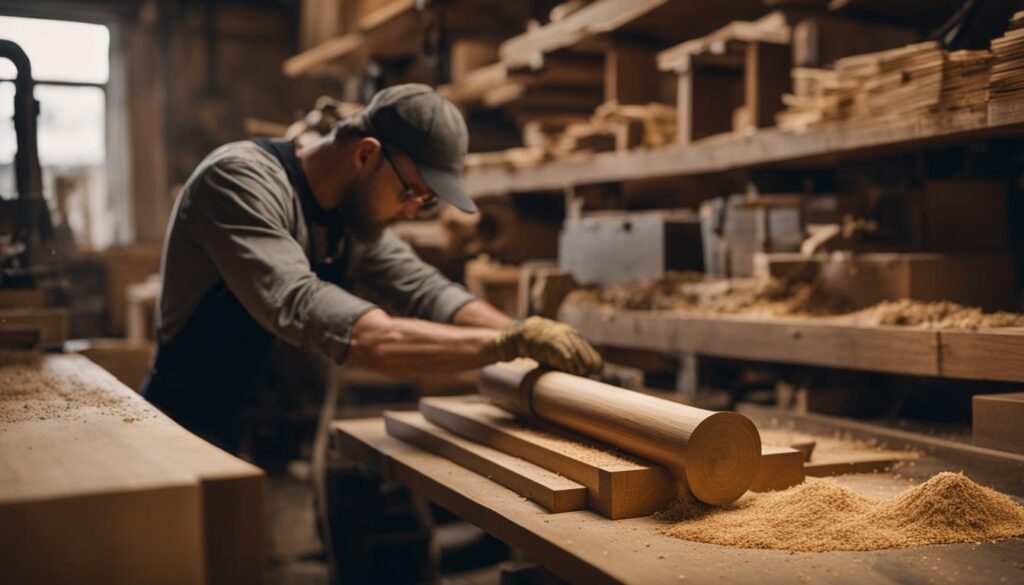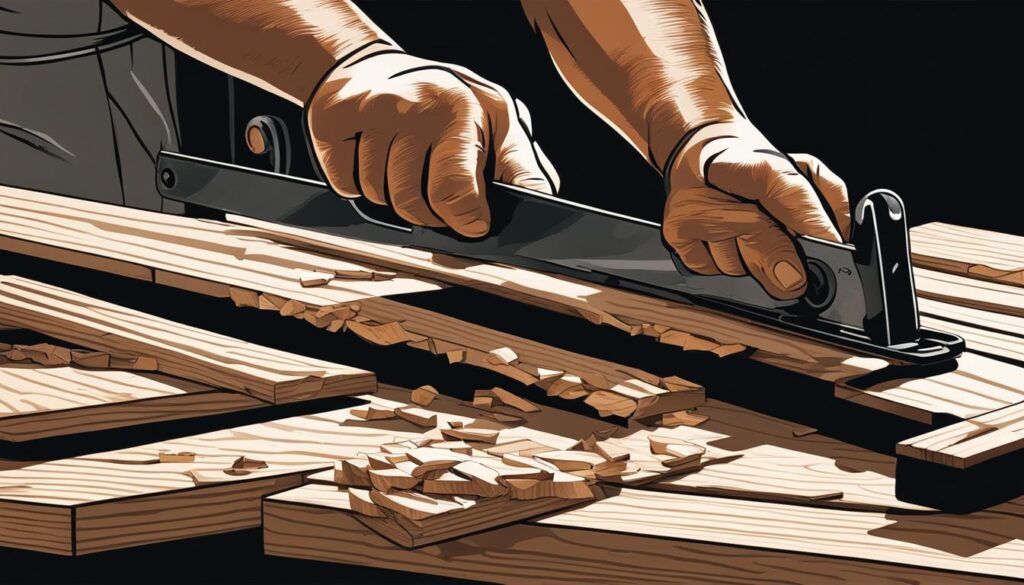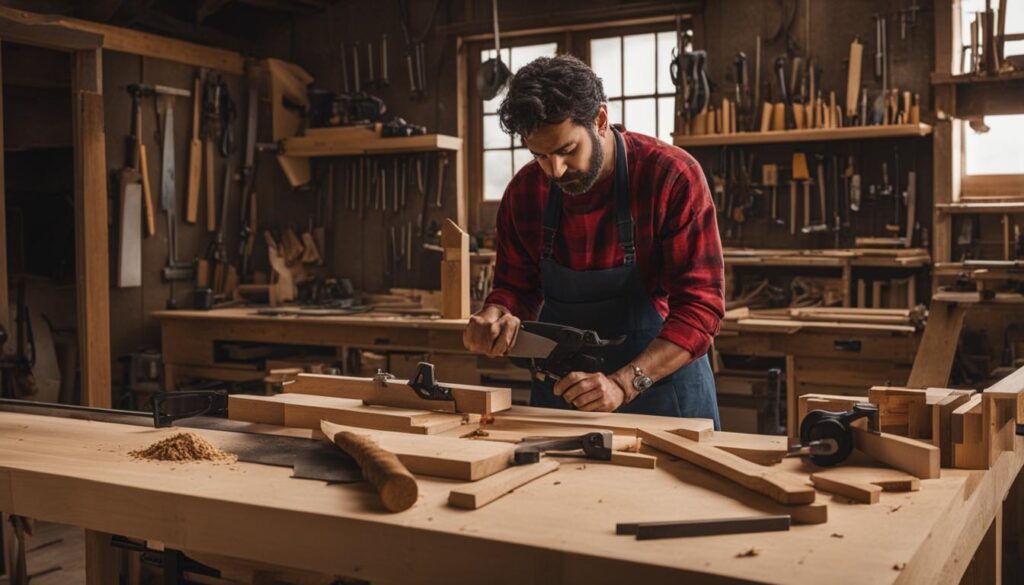We may earn money or products from the companies mentioned in this post.
Are you fascinated by the art of woodturning? Do you dream of creating beautiful wood lathe projects that showcase your skills and creativity? Whether you’re a beginner or an experienced woodturner, mastering wood lathe techniques is essential to achieving professional results and taking your craft to the next level.
In this comprehensive guide on Wood Lathe Techniques, we’ll take you through everything you need to know to perfect your craft. From understanding the basics of wood lathe tools to exploring advanced techniques, you’ll learn how to create stunning wood lathe projects that leave a lasting impression.
Key Takeaways
- Wood lathe techniques are essential to achieving professional results in woodturning projects.
- Becoming familiar with the basic tools and techniques is a crucial starting point.
- From spindle turning to bowl making, there are many beginner-friendly wood lathe projects to try.
- Advanced woodturning techniques like segmented turning and ornamental turning offer endless possibilities for creativity.
- By following valuable tips and tricks, you can enhance the quality of your woodturned pieces.
Understanding the Basics of Wood Lathe Tools
Before diving into specific techniques, it’s important to understand the basic tools used in wood lathe work. These tools are essential for creating any wood lathe project efficiently and with precision. The following are some of the most commonly used wood lathe tools:
| Tool | Usage |
|---|---|
| Spindle Gouge | Used for shaping spindles, such as chair legs, table legs, and other circular objects |
| Bowl Gouge | Used for cutting bowls and other hollow forms. Bowl gouges have a deeper flute than spindle gouges |
| Parting Tool | Used for separating one section of wood from another. For example, you can use a parting tool to separate a spindle from a waste block. |
| Skew Chisel | Used for smoothing out spindles and other turned objects. The flat cutting edge produces a smooth surface |
| Scraper | Used for smoothing out rough surfaces on spindles, bowls, and other turned objects. Scrapers have a flat cutting edge perpendicular to the tool’s axis |
Each tool has a specific function and is used in a particular way. It’s important to learn how to use each tool correctly to avoid accidents and produce high-quality work. In addition to the basic wood lathe tools, there are various woodturning techniques that are fundamental for creating any wood lathe project. These techniques include:
- Spindle Turning
- Bowl Turning
- Hollowing
- Faceplate Turning
Mastering these basic techniques will provide a strong foundation for more advanced projects, and help you produce precise, beautiful results. In the next section, we will explore some simple wood lathe projects that are perfect for beginners to practice these techniques.
Getting Started with Wood Lathe Projects
Now that you have familiarized yourself with the essential wood lathe tools and techniques in our previous section, it’s time to start creating your own projects!
If you are a beginner, it’s best to start with simple wood lathe projects that will help you develop your skills. Spindle turning is a good starting point. It involves turning a square or round blank of wood into a cylinder shape. This technique is easy to learn and provides a great foundation for more advanced techniques.
Another beginner project is bowl making. It involves using a wood lathe to shape a wooden bowl from a blank of wood. Although it requires a bit more skill than spindle turning, it’s still a great project for beginners.
Here is a simple step-by-step process for making a wooden bowl:
| Step | Description |
|---|---|
| 1 | Select a piece of wood that is suitable for bowl making. Hardwoods like maple, cherry, and walnut are good choices. |
| 2 | Mount the wood on the lathe using a chuck or faceplate. Use a roughing gouge to shape the outside of the bowl. |
| 3 | Use a bowl gouge to shape the inside of the bowl. Be sure to make light cuts and take your time to avoid catching the tool on the wood. |
| 4 | Sand the bowl using a progression of grits until it’s smooth. Apply a finish of your choice. |
As you become more comfortable with wood lathe projects, you can start exploring more advanced techniques. For example, you can try segmented turning which involves gluing together different pieces of wood to create a pattern. Hollowing is another advanced technique that involves creating a hollow vessel from a solid piece of wood.
Remember that the key to successful wood lathe projects is practice and patience. Start with simple projects and work your way up to more advanced ones. Before long, you’ll be creating beautiful woodturned pieces that showcase your skills!
Exploring Advanced Wood Lathe Techniques
Now that you’ve mastered the basics of wood lathe techniques, it’s time to take your skills to the next level. In this section, we’ll explore some advanced woodturning techniques that will challenge and inspire you. Let’s dive in!
Segmented Turning
Segmented turning is a technique that involves cutting and gluing together small pieces of wood to create complex patterns and designs. This technique allows for endless creativity and can produce stunning results. Here are some tips to get started:
- Choose the wood species and colors you want to use for your project.
- Cut the wood into small, identical pieces.
- Glue the pieces together in a desired pattern or design.
- Mount the glued segments onto the lathe and turn away the excess wood to reveal the pattern.
Segmented turning requires patience and precision, but the results are worth the effort. Experiment with different patterns and color combinations to create unique pieces that showcase your woodworking skills.
Hollowing
Hollowing is the process of creating a cavity within a woodturned object. This technique is commonly used for creating bowls, vases, and other hollow forms. Here are some tips for successful hollowing:
- Choose a suitable wood species that won’t crack or split during the hollowing process.
- Use a specialized hollowing tool, such as a boring bar or scraper, to carve out the inside of the object.
- Work slowly and carefully to avoid damaging the walls of the object.
Hollowing can be a challenging technique for beginners, but with practice and patience, you can create beautiful and functional hollow forms.
Ornamental Turning
Ornamental turning is a decorative woodturning technique that involves embellishing the surface of an object with intricate patterns and designs. This technique requires specialized equipment, such as a rose engine lathe, to create the desired effects. Here are some tips to get started:
- Invest in a specialized ornamental turning lathe, such as a rose engine lathe.
- Choose the patterns and designs you want to create, such as spirals, stars, and rosettes.
- Set up the lathe and use specialized tools to create the desired effects on the surface of the object.
Ornamental turning is a unique and specialized technique that can produce stunning results. It requires a significant investment in equipment and practice to master, but the end results are worth the effort.
“Advanced wood lathe techniques require patience, precision, and practice. Don’t be afraid to challenge yourself and try new techniques, even if they seem difficult at first.”
By exploring these advanced wood lathe techniques, you can expand your skills and create unique and beautiful pieces that showcase your talent and passion for woodworking. Keep practicing and experimenting, and you’ll be amazed at what you can accomplish!
Wood Turning Tips and Tricks
Wood turning is a craft that requires skill, patience, and attention to detail. Whether you’re a beginner or an experienced woodturner, there are always tips and tricks to help improve your craft. Here are some wood turning basics and tips to help elevate your woodturning game.
1. Select the Right Wood Species
The type of wood you choose will impact the outcome of your project. Soft woods are easier to work with, while hardwoods are more durable. When selecting your wood, consider the grain pattern, color, and density. Experiment with different species to find the ones that work best for your projects.
2. Use Sharp Tools
Sharp tools are essential for achieving smooth cuts and preventing tear-out. Keep your tools sharp by using a sharpening stone or wheel. Dull tools can not only damage your workpiece but also pose a safety hazard.
3. Practice Safe Turning
Woodturning can be dangerous, so it’s important to practice safety measures. Always wear safety glasses, a dust mask, and ear protection. Keep loose clothing and jewelry away from the lathe. Ensure that the lathe is stable and secure before turning it on.
4. Sand, Sand, and Sand Some More
One of the keys to achieving a professional finish is sanding. Start with coarse grit sandpaper and work your way up to finer grits. Sand in the direction of the grain to avoid scratches and swirls. Don’t forget to sand between coats of finish for a smooth final product.
5. Experiment with Finishes
There are numerous finishes to choose from, each with its unique characteristics. Experiment with different finishes to find the ones that work best for your projects. Some popular finishes include Danish oil, lacquer, and wax.
6. Don’t Over-Tighten Chuck Jaws
Over-tightening the chuck jaws can damage your workpiece. Tighten the jaws until they’re snug, but not so tight that they leave indentations or distort the wood. Practice with scrap wood before working on your final project.
7. Take Breaks
Woodturning can be physically and mentally demanding. Take short breaks every hour or so to stretch and rest your eyes. This will help prevent fatigue and ensure that you’re able to produce your best work.
Exploring Wood Lathe Design Ideas
Are you looking to take your wood lathe projects to the next level? One way to do this is by exploring various design ideas that will spark your creativity and help you create unique pieces.
When it comes to wood turning ideas, the possibilities are endless. You can create anything from traditional designs to contemporary concepts that showcase your style and vision. Here are some ideas to get you started:
Geometric Shapes
One way to add interest to your wood lathe projects is by incorporating geometric shapes. This can be achieved by turning squares, triangles, or even hexagons. These shapes can be stacked or nested to create visually striking patterns that are sure to impress.
Natural Edges
If you want to add a touch of nature to your wood lathe projects, consider leaving the bark on the edge of your piece. This is known as a natural edge and can add texture and character to your work.
Embellishments
To add interest and detail to your woodturned pieces, consider adding embellishments such as beads, spirals, or flutes. These can be added using specialized tools and techniques, and can take your projects to the next level.
Contrasting Materials
Another way to add interest to your wood lathe projects is by incorporating contrasting materials. For example, you could turn a wooden bowl with a ceramic or metal inlay. This will create a striking contrast that will draw the eye.
These are just a few wood turning ideas to help inspire your creativity. Don’t be afraid to experiment with different shapes, textures, and embellishments to create truly unique pieces that showcase your skills and style.
Step-by-Step Wood Lathe Tutorial
Are you eager to put your wood lathe techniques into practice? Follow along with our step-by-step wood lathe tutorial and create a beautiful woodturned piece. For this project, we will be making a wooden bowl.
Materials
- 1 blank of wood (approximately 8″ x 8″ x 3″)
- Wood lathe
- Chisels (gouge, scraper, parting tool)
- Face mask and safety glasses
- Calipers
- Sandpaper (120-grit, 220-grit, 320-grit)
- Beeswax or other wood finish
Instructions
- Place the blank of wood on the wood lathe and secure it with the drive and live centers. Make sure the wood is centered and secure.
- Start the lathe at a slow speed and use the roughing gouge to shape the outside of the bowl. Create a cylinder shape with the gouge and take off the corners until the blank is round.
- Use the calipers to measure the thickness of the walls and bottom of the bowl. Continue shaping the bowl until it reaches the desired thickness.
- With the bowl still on the lathe, use the scraper to smooth out any roughness and refine the shape.
- Use the parting tool to create a tenon on the bottom of the bowl. The tenon will be used to hold the bowl in place when turning the inside.
- Remove the bowl from the lathe and turn it around, securing it to the lathe with the tenon in the chuck. Begin turning the inside of the bowl with the gouge. Be careful not to remove too much material and make the walls too thin.
- Use the calipers to measure the thickness of the walls and bottom of the bowl. Once you’ve achieved the desired thickness, use the scraper to smooth out any roughness and refine the shape of the inside of the bowl.
- Remove the bowl from the lathe and sand it with 120-grit sandpaper. Continue sanding with 220-grit and 320-grit sandpaper until the surface is smooth.
- Apply a wood finish of your choice, such as beeswax or oil.
- Your wooden bowl is complete!
Remember to always wear a face mask and safety glasses when operating the wood lathe. Take your time and be patient – wood turning is a process that requires attention to detail and precision.
Conclusion
Wood lathe techniques are a fascinating branch of woodworking that can lead to endless possibilities. With this comprehensive guide, you now have the knowledge and skills to take your woodturning to the next level. But the journey doesn’t stop here!
Explore Woodturning Projects
Put your skills to the test and explore exciting woodturning projects. From practical objects like bowls and platters to decorative objects like vases and candlesticks, the possibilities are endless. With your newfound skills and creativity, you can create unique and beautiful pieces that showcase your talent and passion for woodworking.
Whether you’re a beginner or an experienced woodturner, there’s always something new to learn and discover. Keep experimenting, keep pushing the boundaries, and keep creating!
FAQ
What are wood lathe techniques?
Wood lathe techniques refer to a variety of methods and skills used in woodturning, which is the process of shaping wood using a lathe. These techniques include spindle turning, bowl turning, hollowing, segmented turning, and ornamental turning, among others.
Who can benefit from learning wood lathe techniques?
Wood lathe techniques can benefit anyone interested in woodworking and creating beautiful wooden objects. Whether you are a beginner or an experienced woodturner, mastering these techniques will enhance your skills and allow you to create stunning wood lathe projects.
What tools are essential for wood lathe work?
Essential tools for wood lathe work include a lathe (machine), turning tools (such as gouges, scrapers, and parting tools), a chuck or faceplate for securing the wood, and a variety of measuring and marking tools. These tools allow you to shape, cut, and finish the wood with precision and control.
How do I get started with wood lathe projects?
To get started with wood lathe projects, it’s recommended to begin with simple projects suitable for beginners. Examples include spindle turning to create items like pens or candlesticks, or bowl turning to create bowls or shallow dishes. Start with basic techniques and gradually progress to more complex projects as you gain confidence and experience.
Are there any safety precautions I should take when using a wood lathe?
Yes, safety should be a priority when using a wood lathe. Always wear appropriate protective gear, such as safety glasses and a face shield, to protect your eyes and face from flying wood chips. Ensure that the lathe is properly secured and stable. Take your time and work at a comfortable pace, avoiding any sudden or jerky movements. Familiarize yourself with the lathe’s operating manual and follow all safety guidelines provided.
How can I achieve smooth finishes on my wood lathe projects?
Achieving smooth finishes on wood lathe projects requires proper sanding and finishing techniques. Start with coarse-grit sandpaper and gradually work your way up to finer grits, ensuring that you sand with the grain of the wood. After sanding, apply a suitable wood finish, such as oil, wax, or lacquer, to protect and enhance the appearance of the wood.
Where can I find inspiration for wood lathe design ideas?
Inspiration for wood lathe design ideas can be found in various sources. Browse woodworking magazines and books, visit woodworking websites and forums, or attend woodturning exhibitions and demonstrations. Nature, architecture, and everyday objects can also serve as inspiration for unique and creative wood lathe designs.
Are there any online tutorials available for wood lathe projects?
Yes, there are numerous online tutorials available for wood lathe projects. Many woodworking websites, YouTube channels, and online marketplaces offer step-by-step tutorials, video demonstrations, and downloadable project plans. These resources can provide detailed instructions and guidance for creating specific wood lathe projects.
Affiliate Disclosure: This post may contain affiliate links. If you purchase through our link, we may receive a small commission, but at no additional cost to you. For more information, please see our Disclosure statement.



